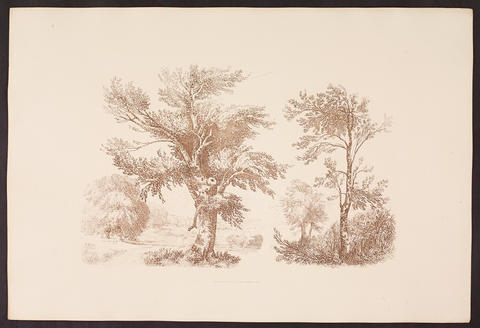License:
 This image is provided under a Creative Commons BY-NC-SA License. You can download this version for private study or non-commercial use. Our terms, conditions and copyright policy (PDF) contains further information about acceptable usage. If you are seeking permission to publish, please contact us ›
This image is provided under a Creative Commons BY-NC-SA License. You can download this version for private study or non-commercial use. Our terms, conditions and copyright policy (PDF) contains further information about acceptable usage. If you are seeking permission to publish, please contact us ›
Please click here if you would like to request a larger, high-resolution version ›
Key Information
Reference code
Title
Date(s)
- 1840 (Creation)
Level of description
Item
Extent
55/59
Content and Structure
Scope and content
Two studies of trees; beech and ash. From "A Treatise on Landscape Painting and Effect in Watercolours: from the first rudiments to the finished picture: with examples in Outline, Effect, and Colouring", first published in London by S & J Fuller in 1814, republished in 1840.
Appraisal, destruction and scheduling
Accruals
System of arrangement
General Information
Name of creator
Biographical history
Born Birmingham, 29 Apr 1783; died Harborne, 7 Jun 1859. English landscape painter, mainly in watercolour. In his youth he worked as a scene painter in Birmingham, then in 1804 moved to London, where he took up watercolour, receiving lessons from John Varley. He lived in Hereford, 1814–27, and in London, 1827–41, before retiring to Harborne, near Birmingham (it is now a suburb of the city), from where he made annual sketching tours to the Welsh mountains. In spite of a certain anecdotal homeliness, his style was broad and vigorous, and in 1836 he began to paint on a rough Scottish wrapping paper that was particularly suited to it. A similar paper was made commercially and marketed as ‘Cox Paper’. Cox devoted much time to teaching and wrote several instruction books on watercolour.
Name of creator
Biographical history
English aquatint-engraver. He was apprenticed to the line engraver John Paas ( fl c1770-1805) on 15 March 1795 and enrolled in the Royal Academy Schools on 3 February 1801. He was soon established as one of the leading aquatint-engravers, at first publishing most of his prints himself. His main early work was ten sets, each of four prints, of sporting subjects after Dean Wolstenholme (1757-1837) which he published between 1806 and 1814. After about 1815 he worked for other publishers, both on singly issued sporting prints and on illustrated books, notably for David Cox's Treatise of Landscape Painting (London, 1813-14) and William Henry Pyne's The History of the Royal Residences (London, 1816-19). He appears to have stopped engraving about 1820. His son Richard Gilson Reeve (1803-89) began to sign plates from about 1826, at first as "Reeve Junr" but thereafter as "R. G. Reeve", and most authorities have failed to distinguish between their work. The younger man worked on illustrated books such as William Westall's and S. Owen's (1769-1857) A Picturesque Tour of the River Thames (London, 1828). Richard Gilson Reeve's brother, Augustus William Reeve (c1807-1880), also worked in aquatint.
Archival history
Custodial history
Physical Description and Conditions of Use
Conditions governing access
Conditions governing reproduction
Language of material
Script of material
Language and script notes
Physical Description
lithograph
Dimensions: 375 x 560 mm
Finding aids
Related Material
Existence and location of originals
Existence and location of copies
Related materials
Notes area
Alternative identifier(s)
Keywords/Tags
Place access points
People and Organisations
Genre access points
Status
Level of detail
Processing information
Language(s)
Script(s)
Sources
Digitised item metadata
Filename
NMC_0230CCC.jpg
Latitude
Longitude
Media type
Image
Mime-type
image/jpeg


